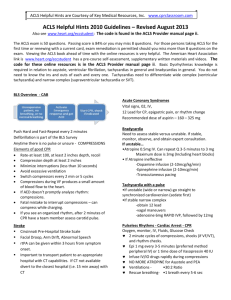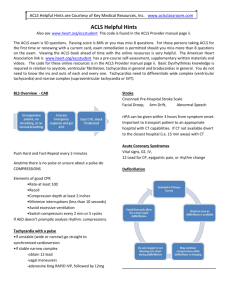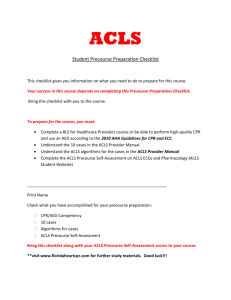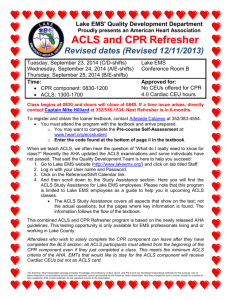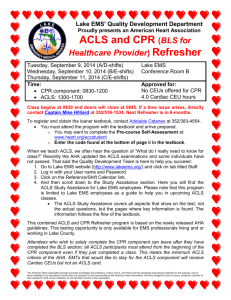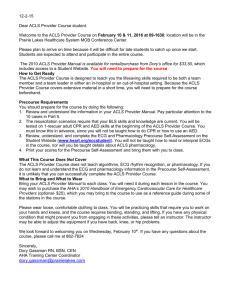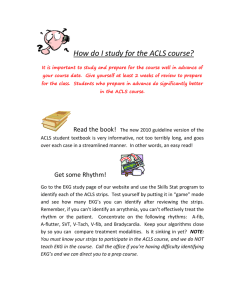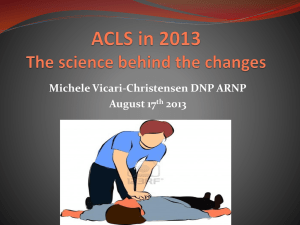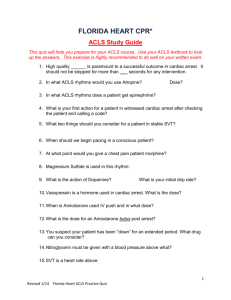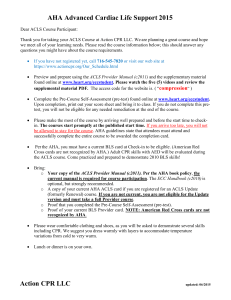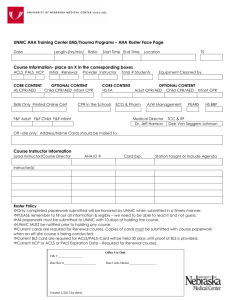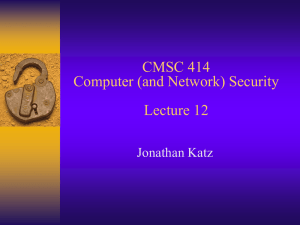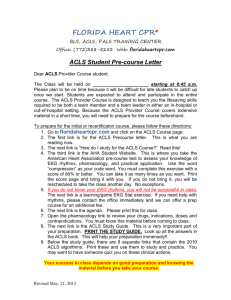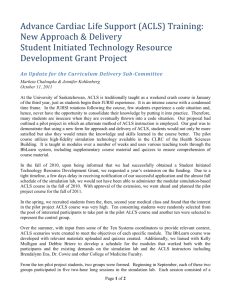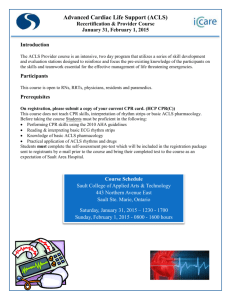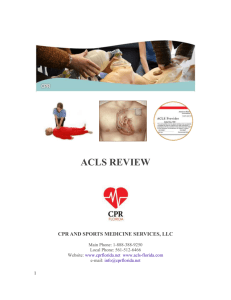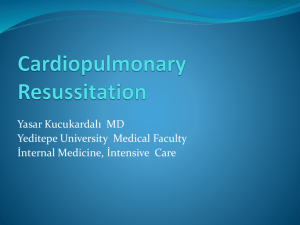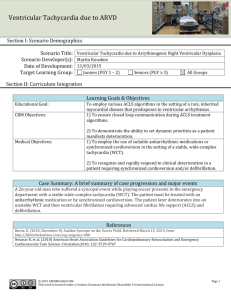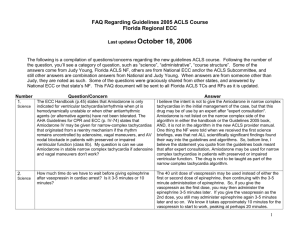ACLS Study Guide 2011
advertisement
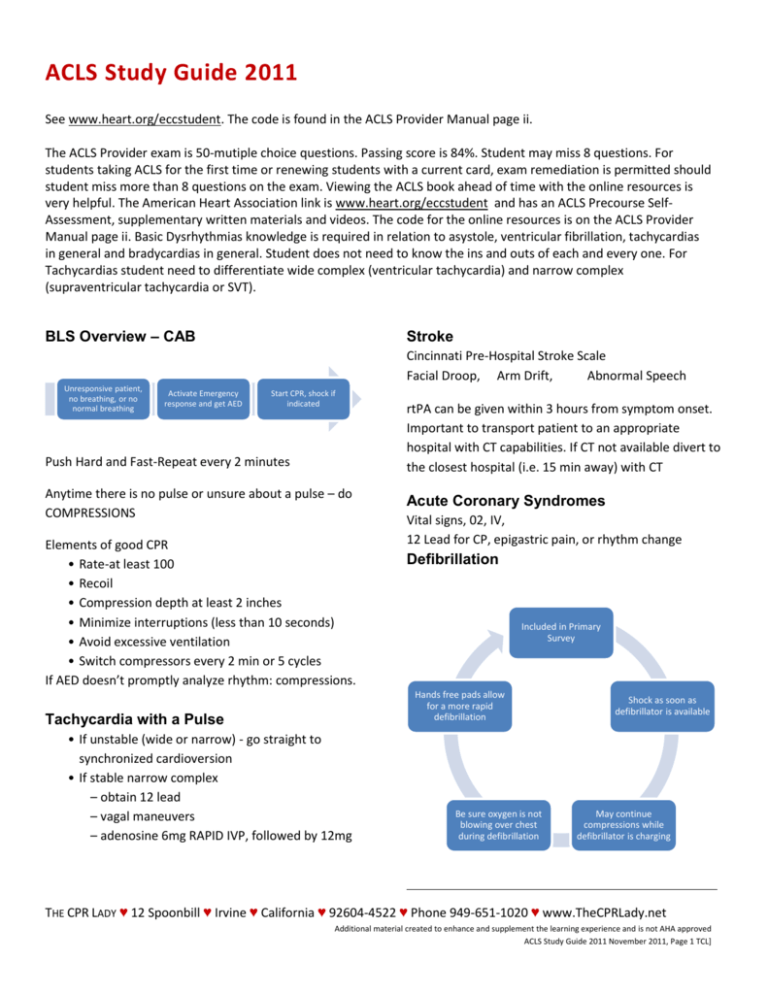
ACLS Study Guide 2011 See www.heart.org/eccstudent. The code is found in the ACLS Provider Manual page ii. The ACLS Provider exam is 50-mutiple choice questions. Passing score is 84%. Student may miss 8 questions. For students taking ACLS for the first time or renewing students with a current card, exam remediation is permitted should student miss more than 8 questions on the exam. Viewing the ACLS book ahead of time with the online resources is very helpful. The American Heart Association link is www.heart.org/eccstudent and has an ACLS Precourse SelfAssessment, supplementary written materials and videos. The code for the online resources is on the ACLS Provider Manual page ii. Basic Dysrhythmias knowledge is required in relation to asystole, ventricular fibrillation, tachycardias in general and bradycardias in general. Student does not need to know the ins and outs of each and every one. For Tachycardias student need to differentiate wide complex (ventricular tachycardia) and narrow complex (supraventricular tachycardia or SVT). BLS Overview – CAB Stroke Cincinnati Pre-Hospital Stroke Scale Facial Droop, Arm Drift, Abnormal Speech Unresponsive patient, no breathing, or no normal breathing Activate Emergency response and get AED Start CPR, shock if indicated Push Hard and Fast-Repeat every 2 minutes Anytime there is no pulse or unsure about a pulse – do COMPRESSIONS Elements of good CPR • Rate-at least 100 • Recoil • Compression depth at least 2 inches • Minimize interruptions (less than 10 seconds) • Avoid excessive ventilation • Switch compressors every 2 min or 5 cycles If AED doesn’t promptly analyze rhythm: compressions. rtPA can be given within 3 hours from symptom onset. Important to transport patient to an appropriate hospital with CT capabilities. If CT not available divert to the closest hospital (i.e. 15 min away) with CT Acute Coronary Syndromes Vital signs, 02, IV, 12 Lead for CP, epigastric pain, or rhythm change Defibrillation Included in Primary Survey Hands free pads allow for a more rapid defibrillation Tachycardia with a Pulse • If unstable (wide or narrow) - go straight to synchronized cardioversion • If stable narrow complex – obtain 12 lead – vagal maneuvers – adenosine 6mg RAPID IVP, followed by 12mg Be sure oxygen is not blowing over chest during defibrillation Shock as soon as defibrillator is available May continue compressions while defibrillator is charging THE CPR LADY ♥ 12 Spoonbill ♥ Irvine ♥ California ♥ 92604-4522 ♥ Phone 949-651-1020 ♥ www.TheCPRLady.net Additional material created to enhance and supplement the learning experience and is not AHA approved ACLS Study Guide 2011 November 2011, Page 1 TCL] Waveform Capnography in ACLS (PETCO2) Allows for accurate monitoring of CPR Most reliable indicator for ET tube placement <10 >10 35-40 •Assess CPR Quality •Compressions Adequate •Post Arrest Target range Bradycardia Need to assess stable versus unstable. If stable, monitor, observe, and consult. If unstable. . . •Atropine 0.5mg IV. Can repeat Q3-5 minutes. Maximum dose=3mg (Including heart blocks) • If Atropine ineffective – Transcutaneous pacing – Dopamine infusion (2-10mcg/kg/min) – Epinephrine infusion (2-10mcg/min) Cardiac Arrest Return of Spontaneous Circulation (ROSC) Post Resuscitation Care Shockable Rhythms: – Ventricular Fibrillation (VF) – Ventricular Tachycardia (VT) without pulse •Maintain 02 sat>94% •Consider adv. airway and waveform capnography •Do not hyperventilate First Priority Biphasic: 120-200J Monophasic: 360J Optimize Ventilation and Oxygenation Non-Shockable Rhythms: – PEA – Asystole • 2 minute cycles of compressions, shocks (if VF/VT), and rhythm checks. • Epi 1 mg every 3-5 minutes (preferred method IV) • NO MORE ATROPINE for Asystole and PEA • Ventilations – 30:2 Ratio • Rescue breathing – 1 breath every 5-6 sec • If advanced airway – 8-10 ventilations/minute Treat Hypotension SBP<90mmHg Does the patient follow commands? Treat reversible causes (Hs and Ts) Hypoxia or ventilation problems Hypovolemia Hypothermia Hypo-/hyper-kalemia Hydrogen ion (acidosis) •IV bolus (1-2L NS or LR) •Vasopressor infusion •Epinephrine •Dopamine •Consider treatable causes •12-Lead ECG - Look for STEMI if so, cath lab •Yes - hypothermia contraindicated •No - consider induced hypothermia Points to Ponder Tamponade, cardiac Tension pneumothorax Toxins – poisons, drugs Thrombosis – coronary (AMI) – pulmonary (PE) COMPRESSIONS are very important. Rigor mortis is an indicator of termination of efforts. Simple airway maneuvers, such as a head-tilt, may help. The Medical Emergency Teams (MET) can identify and treat pre-arrest situations. Consider terminating efforts after deterioration to asystole and prolonged resuscitation time. Use of American Heart Association materials in an educational course does not represent course sponsorship by the American Heart Association. Any fees charged for such a course, except for a portion of fees needed for AHA course materials, do not represent income to the Association. THE CPR LADY ♥ 12 Spoonbill ♥ Irvine ♥ California ♥ 92604-4522 ♥ Phone 949-651-1020 ♥ www.TheCPRLady.net Additional material created to enhance and supplement the learning experience and is not AHA approved ACLS Study Guide 2011 November 2011, Page 2 TCL]

